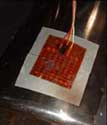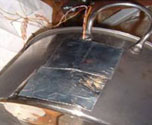Heat Flux Report January 2006, Dale Andreatta, January 2006


Introduction
Omega Engineering makes a small heat flux sensor, a thin device about 25 mm by 25 mm
with 40 embedded thermocouples, which puts out a voltage proportional to the heat flux
through the device. This device was used to perform a series of experiments designed to
begin to answer the following questions:
- In a cooking pot that is being heated, where does the heat enter the pot, the bottom
- center, bottom edges, the sides, or uniformly?
- How much of the heat is transferred through radiation vs. how much of the heat is
- transferred through convection?
- Can one measure the temperature distributions in the gas around the pot, and can
- anything be learned about the heat transfer from these temperature distributions?
- Can the heat flux sensor be used to determine the effectiveness of skirts?
Heat flux is defined as heat flow per unit area, and the units are Watts/m2. Another
concept is heat flow, which is the total amount of heat being moved, in Watts. Heat flow
is the integral of the heat flux over the total area, or in other words, the average heat flux times the total area.
In science, it is often useful to compare the conclusions and results with conclusions
drawn from other measurements. If the measurements are consistent, this gives us
confidence that the measurements are accurate. If the measurements are not consistent,
the results may be reported, but the inconsistencies must also be pointed out. In this
report, a rigorous effort will be made to find inconsistencies, both within the data that
was measured, and in comparison with other data that was previously measured.
For more detail, see the attached report:
http://www.bioenergylists.org/files/Heat_Flux_Report_January_2006.pdf
